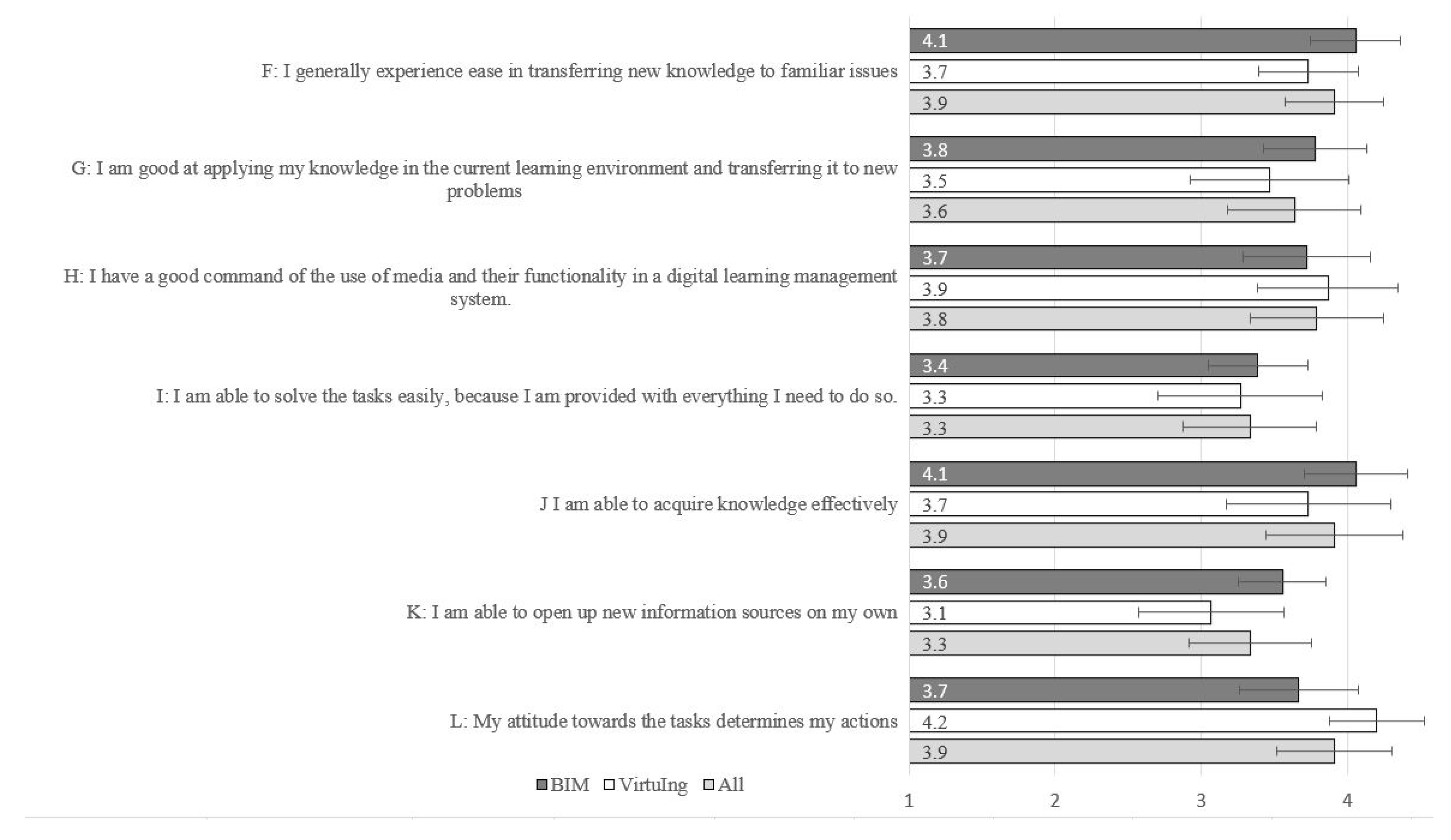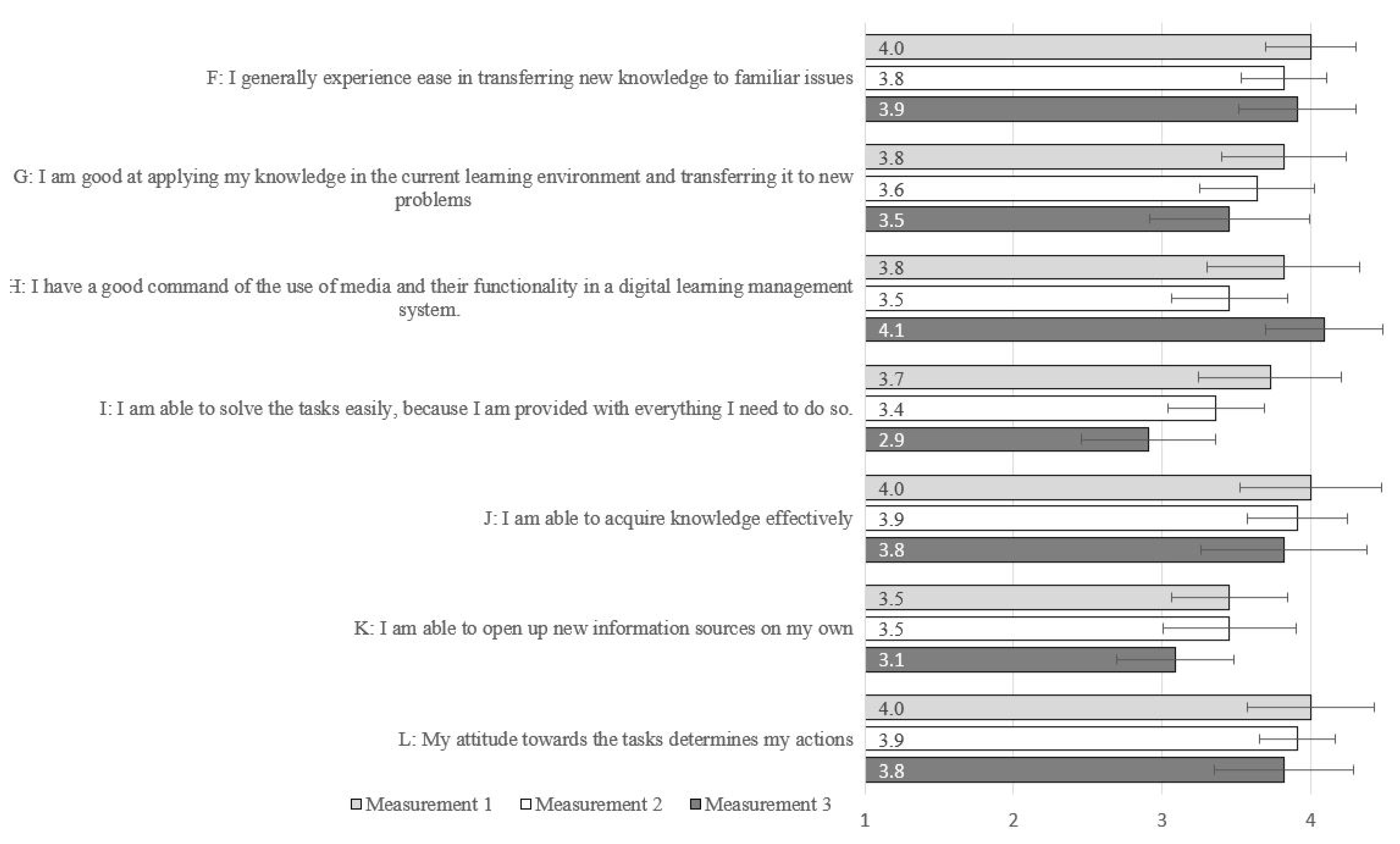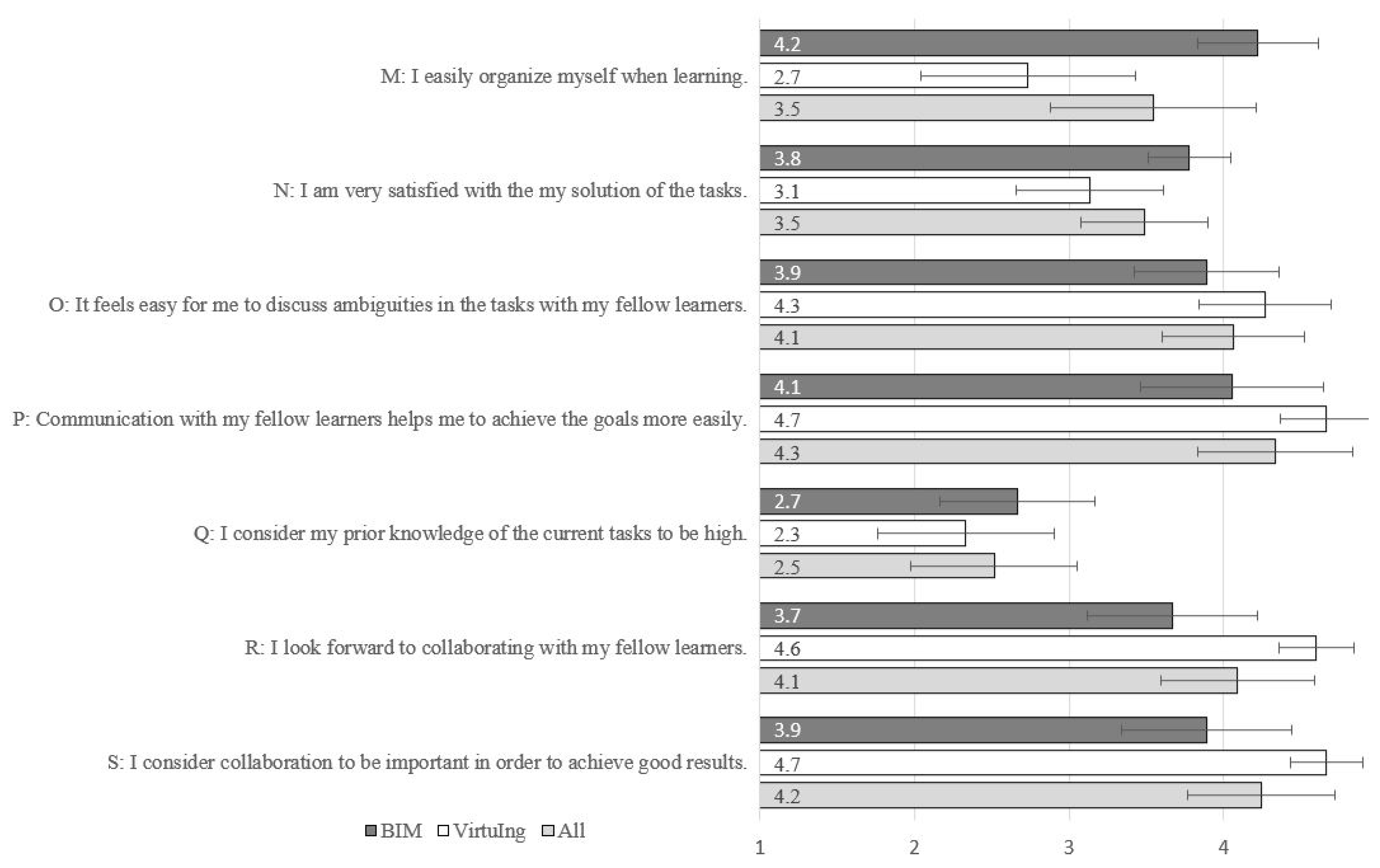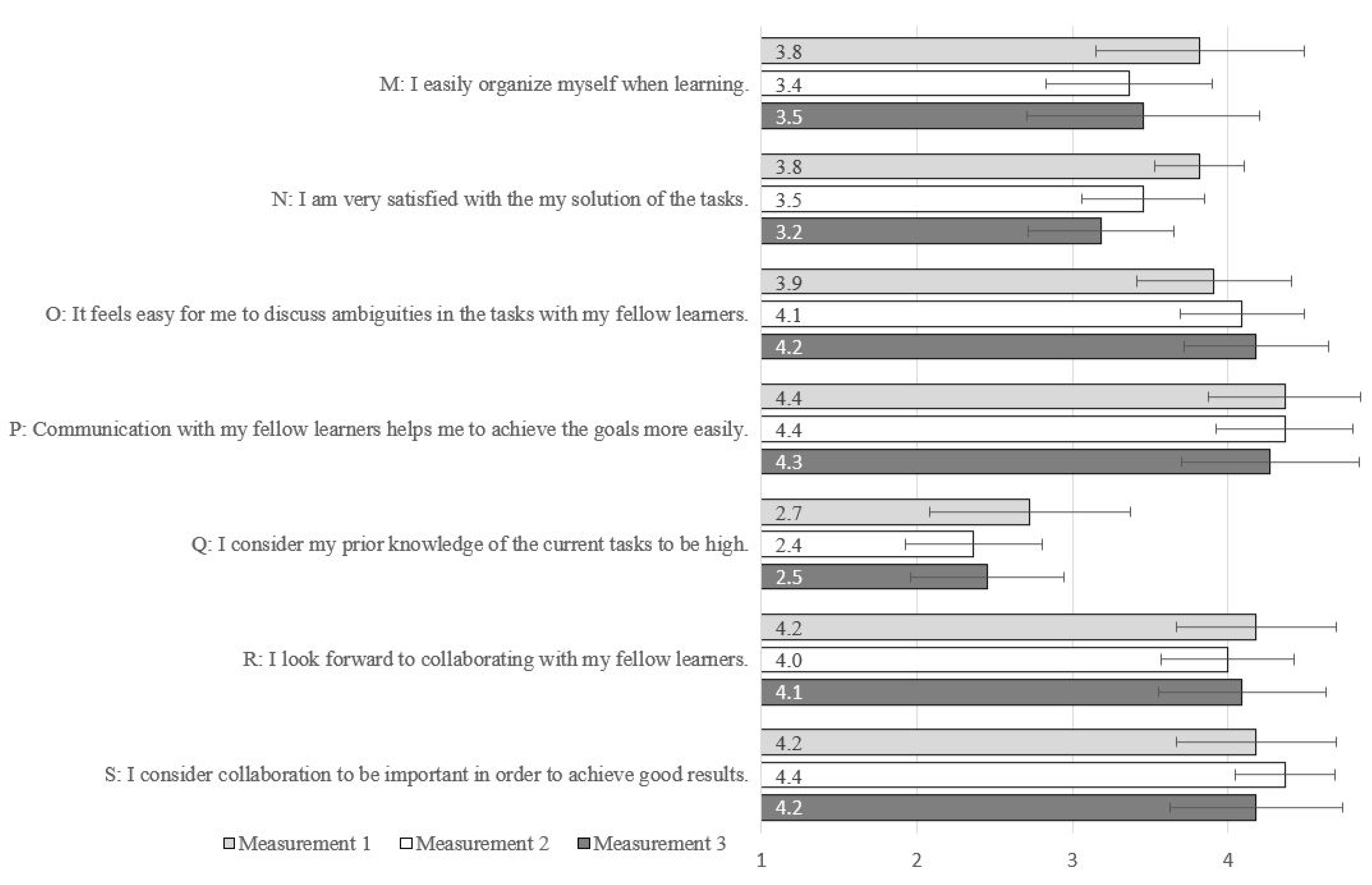Teaching (Meta) Competences for Digital Practice Exemplified by Building Information Modeling Work Processes
Abstract
:1. Introduction
1.1. Competences
1.2. Competence Profiles
1.3. Meta Competences
1.4. Building Information Modeling
1.5. Study Aim
2. Methodology
3. Results
3.1. Demography
3.2. Learning
3.3. Questionnaire
3.3.1. Task Attractiveness
3.3.2. Learning
3.3.3. Self-Organization
3.4. Semi-Structured Interviews
3.4.1. Task Evaluation
3.4.2. Satisfaction and Challenges
3.4.3. Effects of the Course
3.4.4. Practical Relevance
3.4.5. Competences Demanded
3.4.6. Digital Competences
4. Discussion
5. Conclusions
Author Contributions
Funding
Institutional Review Board Statement
Informed Consent Statement
Data Availability Statement
Conflicts of Interest
References
- Rohrbach-Schmidt, D.; Tiemann, M. Changes in workplace tasks in Germany—Evaluating skill and task measures. J. Labour Mark. Res. 2013, 46, 215–237. [Google Scholar] [CrossRef]
- Cijan, A.; Jenič, L.; Lamovšek, A.; Stemberger, J. How digitalization changes the workplace. Dyn. Relatsh. Manag. J. 2019, 8, 3–12. [Google Scholar] [CrossRef]
- Alabdulkareem, A.; Frank, M.R.; Sun, L.; AlShebli, B.; Hidalgo, C.; Rahwan, I. Unpacking the polarization of workplace skills. Sci. Adv. 2018, 4, eaao6030. [Google Scholar] [CrossRef] [PubMed]
- Rychen, D.S.; Salganik, L.H. Definition and Selection of Key Competencies. In The Ines Compendium (Fourth General Assembly of the OCDE Education Indicators Programmme); OCDE: Tokyo, Japan, 2000; pp. 61–73. [Google Scholar]
- Weinert, F.E. Concept of Competence: A Conceptual Clarification. In Defining and Selecting Key Competencies; Hogrefe Publishing: Göttingen, Germany, 2001; pp. 45–65. [Google Scholar]
- Le Deist, F.D.; Winterton, J. What is competence? Hum. Resour. Dev. Int. 2005, 8, 27–46. [Google Scholar] [CrossRef]
- Hartig, J.; Klieme, E. Kompetenz und Kompetenzdiagnostik. In Leistung Und Leistungsdiagnostik; Springer: Berlin/Heidelberg, Germany, 2006; pp. 127–143. [Google Scholar] [CrossRef]
- Rychen, D.S.; Salganik, L.H. Key Competencies for a Successful Life and Well-Functioning Society; Hogrefe Publishing: Göttingen, Germany, 2003. [Google Scholar]
- Rychen, D.S.; Salganik, L.H. Defining and Selecting Key Competencies; Hogrefe & Huber Publishers: Göttingen, Germany, 2001. [Google Scholar]
- Mahasneh, J.K.; Thabet, W. Rethinking Construction Curriculum: A Descriptive Cause Analysis for Soft Skills Gap among Construction Graduates. In Proceedings of the 51st ASC Annual International Conference, College Station, TX, USA, 22–25 April 2015; Texas A&M University: College Station, TX, USA, 2015; pp. 1–8. Available online: http://ascpro0.ascweb.org/archives/cd/2015/paper/CEUE391002015.pdf (accessed on 21 June 2022).
- Niegemann, H.M.; Domagk, S.; Hessel, S.; Hein, A.; Hupfer, M.; Zobel, A. Kompendium Multimediales Lernen; Springer: Berlin/Heidelberg, Germany, 2008. [Google Scholar] [CrossRef]
- Shavelson, R.J. On the measurement of competency. Empir. Res. Vocat. Educ. Train. 2010, 2, 41–63. [Google Scholar] [CrossRef]
- Davis, B.D.; Miller, T.R. Job Preparation for the 21st Century: A Group Project Learning Model to Teach Basic Workplace Skills. J. Educ. Bus. 1996, 72, 69–73. [Google Scholar] [CrossRef]
- Nugraha, H.D.; Kencanasari, R.A.V.; Komari, R.N.; Kasda, K. Employability Skills in Technical Vocational Education and Training (TVET). Innov. Vocat. Technol. Educ. 2020, 16, 1–10. [Google Scholar] [CrossRef]
- Chung-Herrera, B.G.; Enz, C.A.; Lankau, M.J. A competencies model: Grooming future hospitality leaders. Cornell Hotel Restaur. Adm. Q. 2003, 44, 17–25. [Google Scholar] [CrossRef]
- Glockshuber, E. Counsellors’ self-perceived multicultural competencies model. Eur. J. Psychother. Couns. 2005, 7, 291–308. [Google Scholar] [CrossRef]
- Baalsrud Hauge, J.; Söbke, H.; Bröker, T.; Lim, T.; Luccini, A.M.; Kornevs, M.; Meijer, S. Current Competencies of Game Facilitators and Their Potential Optimization in Higher Education: Multimethod Study. JMIR Serious Games 2021, 9, e25481. [Google Scholar] [CrossRef] [PubMed]
- Arafeh, L. An entrepreneurial key competencies’ model. J. Innov. Entrep. 2016, 5, 26. [Google Scholar] [CrossRef]
- Dziekoński, K. Project Managers’ Competencies Model for Construction Industry in Poland. Procedia Eng. 2017, 182, 174–181. [Google Scholar] [CrossRef]
- Lukianov, D.; Mazhei, K.; Gogunskii, V. Transformation of the International Project Management Association Project Managers Individual Competencies Model. In Proceedings of the 2019 IEEE International Conference on Advanced Trends in Information Theory (ATIT), Kyiv, Ukraine, 18–20 December 2019; IEEE: Kyiv, Ukraine, 2019; pp. 506–512. [Google Scholar] [CrossRef]
- Brown, R.B. Refrain the Competency Debate: Management Knowledge and Meta-Competence in Graduate Education. Manag. Learn. 1994, 25, 289–299. [Google Scholar] [CrossRef]
- Pereira, O.P. Soft skills: From university to the work environment. Analysis of a survey of graduates in Portugal. Reg. Sect. Econ. Stud. 2013, 13, 105–118. [Google Scholar]
- Stevens, M.; Norman, R. Industry Expectations of Soft Skills in IT Graduates, A Regional Survey. In Proceedings of the Australasian Computer Science Week Multiconference, Canberra, Australia, 1–5 February 2016. [Google Scholar] [CrossRef]
- Caratozzolo, P.; Alvarez-Delgado, A.; Gonzalez-Pineda, Z.; Hosseini, S. Enhancing Interdisciplinary Skills in Engineering with the Cognitive Tools of Storytelling. In Proceedings of the SEFI 47th Annual Conference 2019—“Varietas Delectat: Complexity Is the New Normality”, Budapest, Hungary, 16–19 September 2019; SEFI: Budapest, Hungary, 2019; pp. 206–215. [Google Scholar]
- Muukkonen, H.; Lakkala, M. Exploring metaskills of knowledge-creating inquiry in higher education. Int. J. Comput. Collab. Learn. 2009, 4, 187–211. [Google Scholar] [CrossRef]
- Guerra-Báez, S.P. A panoramic review of soft skills training in university students. Psicol. Esc. Educ. 2019, 23, e186464. [Google Scholar] [CrossRef]
- Dede, C. Comparing Frameworks for “21st Century Skills”. In 21st Century Skills: Rethinking How Students Learn; Bellance, J., Brandt, R., Eds.; Solution Tree Press: Bloomington, IN, USA, 2009; pp. 51–76. [Google Scholar]
- Matteson, M.L.; Anderson, L.; Boyden, C. “Soft skills”: A phrase in search of meaning. Portal 2016, 16, 71–88. [Google Scholar] [CrossRef]
- Wilkie, D. Employers Say Students Aren’t Learning Soft Skills in College, SHRM. 2019. Available online: https://www.shrm.org/resourcesandtools/hr-topics/employee-relations/pages/employers-say-students-arent-learning-soft-skills-in-college.aspx (accessed on 25 March 2021).
- Sacks, R.; Eastman, C.; Lee, G.; Teicholz, P. BIM Handbook: A Guide to Building Information Modeling for Owners, Designers, Engineers, Contractors, and Facility Managers, 3rd ed.; Wiley: Hoboken, NJ, USA, 2018. [Google Scholar]
- Egger, M.; Hausknecht, K.; Liebich, T.; Przybylo, J. BIM-Leitfaden Für Deutschland. 2014. Available online: papers3://publication/uuid/6A00173D-6403-4F0A-B19C-903574DCB724 (accessed on 23 January 2021).
- Rodriguez, A.K.S.; Suresh, S.; Heesom, D.; Suresh, R. BIM Education Framework for Clients and Professionals of the Construction Industry. Int. J. 3-D Inf. Model. 2017, 6, 57–79. [Google Scholar] [CrossRef]
- Rehman, A.U.; Puolitaival, T.; McMullan, R.; Kestle, L. Competence Development in Advanced and Emerging Construction Technologies. In Proceedings of the 42nd Australasian Universities Building Education Association (AUBEA) Conference 2018: Educating Building Professionals for the Future of the Globalised World, Singapore, 26–28 September 2018; Curtin University: Perth, Australia, 2018. [Google Scholar]
- bSI Professional Certification Steering Committee. Professional Certification: Program Overview. 2021. Available online: https://education.buildingsmart.org/wp-content/uploads/2021/06/bSI_PCERT-F_Doc2.1_Program-Overview_V2.1-June-2021.pdf (accessed on 23 January 2022).
- Succar, B.; Agar, C.; Beazley, S.; Berkemeier, P.; Choy, R.; Di Giangregorio, R.; Donaghey, S.; Linning, C.; Macdonal, J.; Perey, R.; et al. BIM Education, BIM in Practice. In BIM in Practice; Australian Institute of Architects and Consult: Melbourne Australia, 2012. [Google Scholar]
- Moodle.org. Moodle—Open Source Learning Platform. 2018. Available online: https://moodle.org (accessed on 23 May 2018).
- Concerted Solutions. IFC Webserver. Open BIM Server and Online BIM Viewer. 2021. Available online: https://ifcwebserver.org/ (accessed on 2 March 2022).
- buildingSMART Benelux. BIM Basis Information Delivery Specification. 2021. Available online: https://www.bimloket.nl//documents/BIM-ILS_infographicA4_2020_UK_021.pdf (accessed on 23 June 2022).
- Richter, C.; Liedtke, S. BKI IFC Bildkommentar Nach DIN 276: Ausgewählte IFC 4 Begriffe Für Die BIM-Planungsarbeit Gegliedert Nach DIN 276; Baukosteninformationszentrum Deutscher Architektenkammern: Stuttgart, Germany, 2021. [Google Scholar]
- Pagel, M.; Söbke, H.; Bröker, T. Using Multiplayer Online Games for Teaching Soft Skills in Higher Education. In Serious Games; Fletcher, B., Ma, M., Göbel, S., Baalsrud Hauge, J., Marsh, T., Eds.; Springer International Publishing: Berlin/Heidelberg, Germany, 2021; pp. 276–290. [Google Scholar] [CrossRef]
- Jansen, E.; Söbke, H. Communication Skills in Construction Projects and Promoting Them through Multiplayer Online Games. In Serious Games JCSG 2022; Söbke, H., Spangenberger, P., Müller, P., Göbel, S., Eds.; Springer: Berlin/Heidelberg, Germany, 2022. [Google Scholar] [CrossRef]
- CCP. EVE Online. EVE Online. 2012. Available online: http://www.eveonline.com/ (accessed on 19 June 2012).
- Solibri Inc. SOLIBRI. BIM Software for Architects and Engineers. 2021. Available online: https://www.solibri.com/ (accessed on 3 February 2021).
- Schmidt, C. The Analysis of Semi-Structured Interviews. In A Companion to Qualitative Research; Flick, U., Von Kardorff, E., Steinke, I., Eds.; SAGE Publications: London, UK, 2004; pp. 253–258. [Google Scholar]
- Wigfield, A.; Eccles, J.S. Expectancy—Value theory of achievement motivation. Contemp. Educ. Psychol. 2000, 25, 68–81. [Google Scholar] [CrossRef] [PubMed]






| Course BIM | Course VirtuIng |
|---|---|
Domain competences
| Meta competences, such as
|
| BIM Practice Task “Building Model Check” | |
Understanding of complex BIM software
| |
| Cohort | BIM (n = 6) | VirtuIng (n = 5) | ||
|---|---|---|---|---|
| Measurement | Correct (%) | Time Used (s) | Correct (%) | Time Used (s) |
| Measurement 1 | 35 | N/A | 36 | 159 |
| Measurement 2 | 40 | N/A | 48 | 136 |
| Measurement 3 | 55 | N/A | 48 | 120 |
| Cohort | BIM (n = 6) | VirtuIng (n = 5) |
|---|---|---|
| Results | 91% | 87% |
Publisher’s Note: MDPI stays neutral with regard to jurisdictional claims in published maps and institutional affiliations. |
© 2022 by the authors. Licensee MDPI, Basel, Switzerland. This article is an open access article distributed under the terms and conditions of the Creative Commons Attribution (CC BY) license (https://creativecommons.org/licenses/by/4.0/).
Share and Cite
Damek, S.; Söbke, H.; Weise, F.; Reichelt, M. Teaching (Meta) Competences for Digital Practice Exemplified by Building Information Modeling Work Processes. Knowledge 2022, 2, 452-464. https://doi.org/10.3390/knowledge2030027
Damek S, Söbke H, Weise F, Reichelt M. Teaching (Meta) Competences for Digital Practice Exemplified by Building Information Modeling Work Processes. Knowledge. 2022; 2(3):452-464. https://doi.org/10.3390/knowledge2030027
Chicago/Turabian StyleDamek, Sebastian, Heinrich Söbke, Franziska Weise, and Maria Reichelt. 2022. "Teaching (Meta) Competences for Digital Practice Exemplified by Building Information Modeling Work Processes" Knowledge 2, no. 3: 452-464. https://doi.org/10.3390/knowledge2030027
APA StyleDamek, S., Söbke, H., Weise, F., & Reichelt, M. (2022). Teaching (Meta) Competences for Digital Practice Exemplified by Building Information Modeling Work Processes. Knowledge, 2(3), 452-464. https://doi.org/10.3390/knowledge2030027







